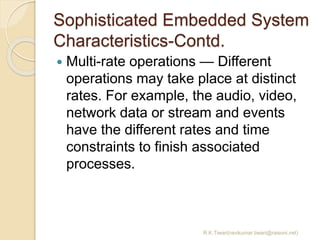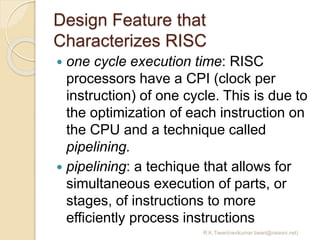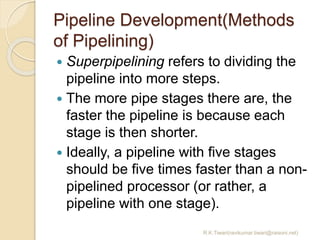Introducing Embedded Systems and the Microcontrollers
- 1. Introducing Embedded Systems and the Microcontrollers Ravikumar Tiwari Assistant Professor Dept. of Electronics, G.H. Raisoni College of Engineering(Autonomous),Nagpur [email protected]
- 2. System Definition R.K.Tiwari([email protected]) A way of working, organizing or performing one or many tasks according to a fixed set of rules, program or plan.
- 3. System Definition R.K.Tiwari([email protected]) • Also an arrangement in which all units assemble and work together according to a program or plan.
- 4. Examples of Systems Time display system – A watch Automatic cloth washing system – A washing machine R.K.Tiwari([email protected])
- 5. Embedded System Definitions: 1. “An embedded system is a system that has software embedded into computer-hardware, which makes a system dedicated for an application (s) or specific part of an application or product or part of a larger system.” – Rajkamal R.K.Tiwari([email protected])
- 6. Embedded System Definitions: 2. “An embedded system is one that has a dedicated purpose software embedded in a computer hardware.” –Rajkamal R.K.Tiwari([email protected])
- 7. Embedded System Definitions: 3. “It is a dedicated computer based system for an application(s) or product. It may be an independent system or a part of large system. Its software usually embeds into a ROM (Read Only Memory) or flash.” – Rajkamal R.K.Tiwari([email protected])
- 8. Embedded System Definitions: “It is any device that includes a programmable computer but is not itself intended to be a general purpose computer.” – Wayne Wolf R.K.Tiwari([email protected])
- 9. Embedded System Definitions: “Embedded Systems are the electronic systems that contain a microprocessor or a microcontroller, but we do not think of them as computers– the computer is hidden or embedded in the system.” – Todd D. Morton R.K.Tiwari([email protected])
- 10. Let’s consider a Computer A computer is a system that has the following or more components. A microprocessor A large memory comprising the following two kinds: (a) Primary memory (semiconductor memories - RAM, ROM and fast accessible caches) R.K.Tiwari([email protected])
- 11. Computer (b) Secondary memory [(magnetic memory located in hard disks, diskettes and cartridge tapes, optical memory in CD-ROM or memory stick (in mobile computer)] using which different user programs can load into the primary memory and can be run. I/O units such as touch screen, modem, fax cum modem etc. R.K.Tiwari([email protected])
- 12. Computer Input units such as keyboard, mouse, digitizer, scanner, etc. Output units like LCD screen, video monitor, printer, etc. Networking units like Ethernet card, front-end processor-based server, bus drivers, etc. Operating system (OS). General purpose user interfaces and application- software, mostly in secondary memory R.K.Tiwari([email protected])
- 13. Now consider Embedded system –Three main embedded components 1.Embeds hardware to give computer like functionalities 2.Embeds main application software generally into flash or ROM and the application software performs concurrently the number of tasks. R.K.Tiwari([email protected])
- 14. Embedded system components 3.Embeds a real time operating system ( RTOS), which supervises the application software tasks running on the hardware and organizes the accesses to system resources according to priorities and timing constraints of tasks in the system. R.K.Tiwari([email protected])
- 15. Embedded system RTOS Enables execution of concurrent processes or threads or tasks Provides a mechanism to let the processor run each process as per scheduling and to do context-switch between the various processes (threads or tasks) RTOS sets the rules during execution of application processes to enable finishing of a process within the assigned time interval and with assigned priority. R.K.Tiwari([email protected])
- 17. Sophisticated Embedded System Characteristics Dedicated functions Dedicated complex algorithms Dedicated (GUIs) and other user interfaces for the application R.K.Tiwari([email protected])
- 18. Sophisticated Embedded System Characteristics-Contd. Real time operations— Defines the ways in which the system works, reacts to the events and interrupts, schedules the system functioning in real time and executes by following a plan to control the latencies and to meet the deadlines. [Latency — Waiting interval between the instance at which a need to run the codes arises for task (or interrupt service routine) following an event and instance of start executing the codes] R.K.Tiwari([email protected])
- 19. Sophisticated Embedded System Characteristics-Contd. Multi-rate operations — Different operations may take place at distinct rates. For example, the audio, video, network data or stream and events have the different rates and time constraints to finish associated processes. R.K.Tiwari([email protected])
- 20. Constraints of an Embedded System Design Available system-memory Available processor speed Limited power dissipation when running the system continuously in cycles of the system start, wait for event, wake-up and run, sleep and stop. R.K.Tiwari([email protected])
- 21. System design constraints Performance, power, size, non-recurring design cost, and manufacturing costs. R.K.Tiwari([email protected])
- 22. RISC RISC, or Reduced Instruction Set Computer. is a type of microprocessor architecture that utilizes a small, highly-optimized set of instructions, rather than a more specialized set of instructions often found in other types of architectures. R.K.Tiwari([email protected])
- 23. Design Feature that Characterizes RISC one cycle execution time: RISC processors have a CPI (clock per instruction) of one cycle. This is due to the optimization of each instruction on the CPU and a technique called pipelining. pipelining: a techique that allows for simultaneous execution of parts, or stages, of instructions to more efficiently process instructions R.K.Tiwari([email protected])
- 24. Design Feature that Characterizes RISC large number of registers: the RISC design philosophy generally incorporates a larger number of registers to prevent in large amounts of interactions with memory R.K.Tiwari([email protected])
- 25. How pipelining Works? Pipelining, a standard feature in RISC processors, is much like an assembly line Because the processor works on different steps of the instruction at the same time, more instructions can be executed in a shorter period of time R.K.Tiwari([email protected])
- 26. How pipelining Works? A useful method of demonstrating this is the laundry analogy. R.K.Tiwari([email protected])
- 27. How pipelining Works? Let's say that there are four loads of dirty laundry that need to be washed, dried, and folded. We could put the the first load in the washer for 30 minutes, dry it for 40 minutes, and then take 20 minutes to fold the clothes. Then pick up the second load and wash, dry, and fold, and repeat for the third and fourth loads. Supposing we started at 6 PM and worked as efficiently as possible, we would still be doing laundry until midnight. R.K.Tiwari([email protected]) Source: http://www.ece.arizona.edu/~ece462/Lec03- pipe/
- 28. How pipelining Works? However, a smarter approach to the problem would be to put the second load of dirty laundry into the washer after the first was already clean and whirling happily in the dryer. Then, while the first load was being folded, the second load would dry, and a third load could be added to the pipeline of laundry. Using this method, the laundry would be finished by 9:30. R.K.Tiwari([email protected]) Source: http://www.ece.arizona.edu/~ece462/Lec03-pipe/ (Source: http://www.inf.fh- dortmund.de/person/prof/si/risc/intro_to_risc/irt0_index.html)
- 29. RISC Pipeline A RISC processor pipeline operates in much the same way, although the stages in the pipeline are different. While different processors have different numbers of steps, they are basically variations of these five, used in the MIPS R3000 processor R.K.Tiwari([email protected])
- 30. RISC Pipeline 1.fetch instructions from memory 2.read registers and decode the instruction 3.execute the instruction or calculate an address 4.access an operand in data memory 5.write the result into a register R.K.Tiwari([email protected])
- 31. RISC Pipeline the length of the pipeline is dependent on the length of the longest step R.K.Tiwari([email protected])
- 32. Pipeline Development(Methods of Pipelining) Superpipelining refers to dividing the pipeline into more steps. The more pipe stages there are, the faster the pipeline is because each stage is then shorter. Ideally, a pipeline with five stages should be five times faster than a non- pipelined processor (or rather, a pipeline with one stage). R.K.Tiwari([email protected])
- 33. Pipeline Development(Methods of Pipelining) Examples; 1.Instruction Fetch (First Half) 2.Instruction Fetch (Second Half) 3.Register Fetch 4.Instruction Execute 5.Data Cache Access (First Half) 6.Data Cache Access (Second Half) 7.Tag Check 8.Write Back R.K.Tiwari([email protected])
- 34. Pipeline Development(Methods of Pipelining) • Superscalar pipelining involves multiple pipelines in parallel. • Internal components of the processor are replicated so it can launch multiple instructions in some or all of its pipeline stages R.K.Tiwari([email protected])
- 35. Pipeline Development(Methods of Pipelining) Dynamic pipelines have the capability to schedule around stalls. A dynamic pipeline is divided into three units: the instruction fetch and decode unit, five to ten execute or functional units, and a commit unit. R.K.Tiwari([email protected])
- 36. Pipeline Development(Methods of Pipelining) Dynamic is combination of Superpipelining & superscalar pipeline R.K.Tiwari([email protected])
- 37. Thank you for you Attention!!! Any Question..?? R.K.Tiwari([email protected])




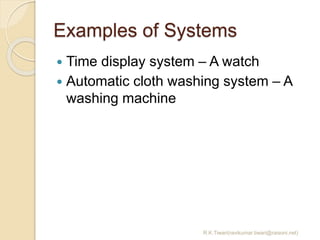

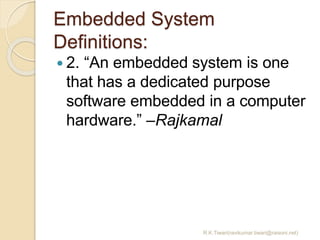




![Computer
(b) Secondary memory [(magnetic
memory located in hard disks,
diskettes and cartridge tapes, optical
memory in CD-ROM or memory stick
(in mobile computer)] using which
different user programs can load into
the primary memory and can be run.
I/O units such as touch screen,
modem, fax cum modem etc.
R.K.Tiwari(ravikumar.tiwari@raisoni.net)](https://image.slidesharecdn.com/unit-ilecture1-150619054603-lva1-app6892/85/Introducing-Embedded-Systems-and-the-Microcontrollers-11-320.jpg)
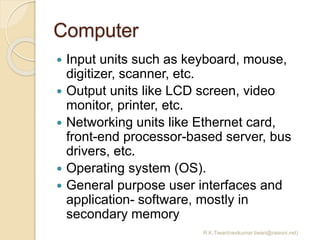


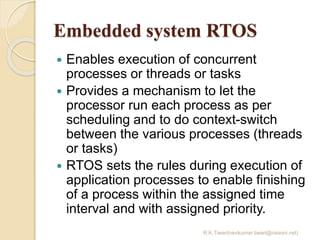
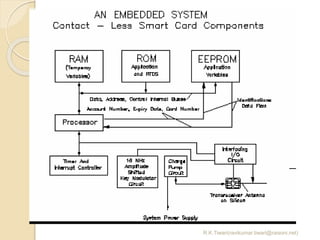

![Sophisticated Embedded System
Characteristics-Contd.
Real time operations— Defines the ways
in which the system works, reacts to the
events and interrupts, schedules the
system functioning in real time and
executes by following a plan to control
the latencies and to meet the deadlines.
[Latency — Waiting interval between the
instance at which a need to run the
codes arises for task (or interrupt service
routine) following an event and instance
of start executing the codes]
R.K.Tiwari(ravikumar.tiwari@raisoni.net)](https://image.slidesharecdn.com/unit-ilecture1-150619054603-lva1-app6892/85/Introducing-Embedded-Systems-and-the-Microcontrollers-18-320.jpg)
